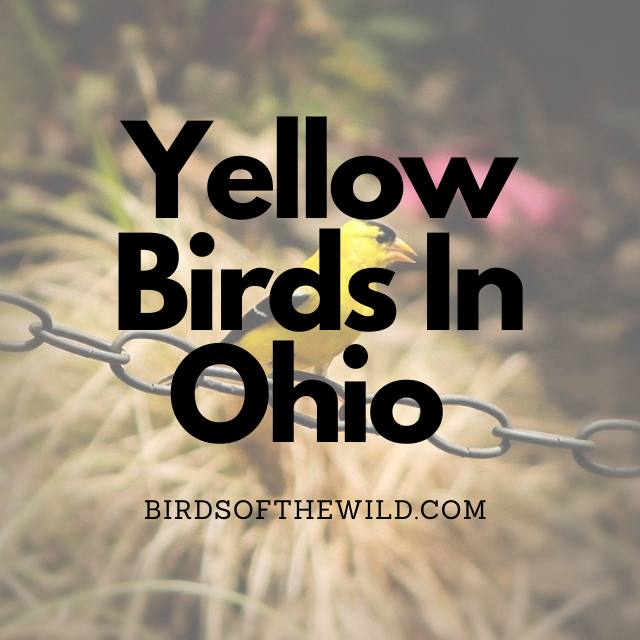In this article I’ll be going over 9 different yellow birds you can lookout for throughout the state of Ohio the next time you go out on a hike or on a birdwatching adventure.
- American Goldfinch
- Common Yellowthroat
- Cedar Waxwing
- American Yellow Warbler
- Yellow Breasted Chat
- White-eyed Vireo
- Hooded Warbler
- Black Throated Green Warbler
- Female Orchard Oriole
9 Yellow Birds In Ohio
1. American Goldfinch (Spinus Tristis)

- Size: 11 – 13cm
- Weight: 11 – 20 grams
- Wingspan: 19 – 22cm
American goldfinches can be found in Ohio year round.
These finches are recognised by their yellow, white and black plumage. Their wings are black and white, their forehead is distinguished by the small black patch on it, their under tail is white with the remainder of the body a bright yellow color. Females are far less vibrant with hints of yellow but are mostly light brown in color.
Ameican goldfinches are found around edges of forests and plains, around areas filled with brush and thistle plants within the state of Minnesota.
These finches tend to eat mainly seeds that come from the daisy composite family, seeds from weeds, from trees like birches and elm trees, buds, the occasional insect, maple sap and berries.
American goldfinches are known to live between 2 – 4 years in the wild and upto 9 years in captivity.
2. Common Yellowthroat (Geothlypis Trichas)

- Size: 11 – 14cm
- Weight: 11 – 15 grams
- Wingspan: 15 – 19cm
Common Yellowthroats are found in Ohio throughout the summer months.
Common yellowthroats are recognised by their mostly light brown/dirty yellow plumage from their head to tail whilst their throat is a bright yellow color. Females are mostly yellow with small elements of yellow on their tail and chin whilst males have more elements of black on their face.
As for where you can find these yellowthroats, they can be located around swamps, marshes, wet thickets, edges where they will often breed within wet marshes as well. They also nest within briars, moist brushy places, tangles of rank weeds and shrubbery along streams and overgrown fields.
Common yellowthroats are known to eat smaller insects like ants, spiders, beetles along with seeds and smaller fruits like berries.
These avians can live for around 11 years in the wild.
3. Cedar Waxwing (Bombycilla Cedrorum)
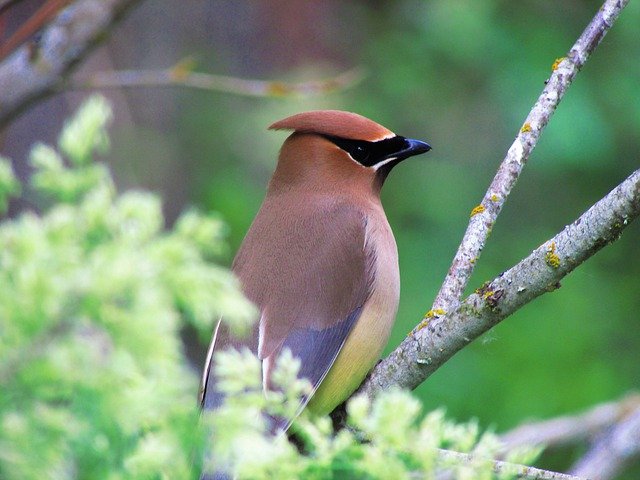
- Size: 15 – 18cm
- Weight: 25 – 35 grams
- Wingspan: 22 – 30cm
Cedar waxwings are permanent residents of Ohio so you’re likely to spot them in the state year round.
They’re recognised by their plumage that have elements of yellow across their body which can be found on their tail and breast with the remainder of their body a gradient brownish/gray color, with a mask shaped black element on their face and a red strip on their wing. Females look very similar to males with main difference being the darker plumage on the males chin.
Cedar waxwings can be found around open woodlands, fruit trees, forest edges, streamsides, overgrown fields, edges of swamps, suburban yards and orchards. In the winter months they can sometimes be seen spending their time in towns.
These avains are known to mostly eat fruits and berries, with the ones they feed on most often being juniper, dogwood, and wild cherries. They also drink the juices from flowers and eat a variety of small insects like beetles, ants, caterpillars etc.
As for their lifespan, they are often known to live for 8 years in wild.
4. American Yellow Warbler (Setophaga Petechia)
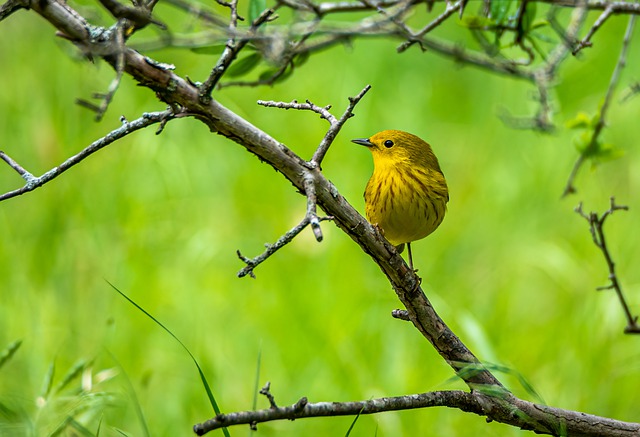
- Size: 12.5 – 13cm
- Weight: 8 – 16 grams
- Wingspan: 16 – 22cm
American yellow warblers can be spotted throughout Ohio when breeding season arrives. This tends to be around the summer months.
American yellow warblers are recognised by their yellow plumage with streaks of brown on its feathers and back. The males have a few more patterns to their plumage but, both the males and females are mostly yellow in color.
As for the habitats in which these little avians tend to spend the majority of their time, it would be bushes, swamp edges, streams and gardens.
Yellow warblers tend to consume insects and berries with 2/3 of their diet mostly consisting of small insects like caterpillars,
beetles, damselflies, treehoppers and more.
These little warblers are known to live upto 10 years. With that being said, they will live closer to 2 – 5 years in the wild as opposed to the full 10.
5. Yellow Breasted Chat (Icteria Virens)

- Size: 17 – 19cm
- Weight: 20 – 34 grams
- Wingspan: 23 – 27cm
Yellow breasted chats can be found throughout Ohio when breeding. They will start breeding between April and May which will then last until fall arrives.
Yellow breasted chats are recognised by their gray/greenish back, wings and forehead, bright yellow chest and white/grayish underside of their lower half. Females have a very similar color scheme but, they are duller looking.
These avians like to spend the majority of their time within thickets among other dense grassy environments where bushes, shrubs and clearcuts are present.
As for the type of food these yellow breasted avians eat, they include small insects like bees, wasps, mayflies, grasshoppers, katydids, caterpillars, spiders among others small variants along with the smaller fruits and berries.
Yellow breasted chats also tend to live for around 5 – 8 years in the wild.
6. White-eyed Vireo (Vireo Griseus)
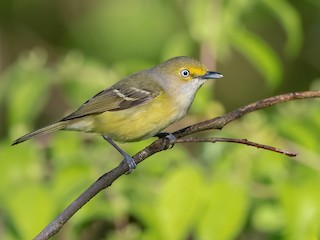
- Size: 11 – 13cm
- Weight: 10 – 14 grams
- Wingspan: 16 – 18cm
White eyed vireos can be found around Ohio when breeding season arrives. This like most other birds starts around mid – late spring and ends around mid – late fall.
These white eyed vireos are recognised by their yellow, gray and green plumage with the neck a gray color, their back and wings a mixture of green and yellow with their breast and belly mostly yellow. Females follow the same color scheme but are less vibrant.
You’ll find these vireos around scrubby areas like overgrown pastures, forested edges, streamside thickets, second-growth forests, and bramble-filled fields.
As for what a white eyed vireo eats, it includes insects like caterpillars, flies, beetles, moths, butterflies among other smaller insects. Fruits and berries are also a part of their diet.
The longest lifespan for a white eyed vireo was recorded to be around 10 years and 11 months. Of course, the average lifespan is much shorter being around the 5 – 7 year range.
7. Hooded Warbler (Setophaga Citrina)

- Size: 11 – 14cm
- Weight: 9 – 12 grams
- Wingspan: 17 – 19cm
You can spot hooded warblers in Ohio when they are breeding. The months you can find them in this case would be between April and November
Hooded warblers are recognised by their dirty yellow wings, yellow breast, yellow face, black head and chin. Females are mostly the same in color but have fewer black elements on their plumage.
They can be found within mature deciduous forests with a dense understory, as well as smaller forest patches around a shrubby understory.
As for what hooded warblers eat, they can feed on smaller insects and arthopods like caterpillars, moths, grasshoppers, beetles, flies, among other smaller insects and they do also eat fruits like berries.
Hooded warblers can live for around 8 years, which isn’t too long or too short for these smaller birds.
8. Black Throated Green Warbler (Setophaga Virens)
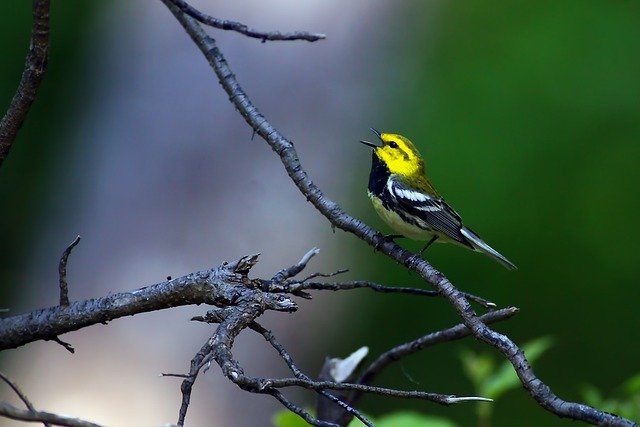
- Size: 11 – 12cm
- Weight: 7 – 11 grams
- Wingspan: 17 – 20cm
Black throated green warblers can be found mostly making passage through the state when migrating out although some appear to breed there, specifically around northeast Ohio. Breeding season usually begins around late spring (April – May) and ends as fall arrives.
These birds are recognised by their yellow, green head and upper back, gray wings, black throat and white belly/breast with a green hue. Females look much the same but, have a duller color palate and the black throat is mostly gray/white for them.
You’ll often find these little birds around a wide variety of forest habitats like conifer forests or mixed hardwood forests as well as cypress swamps on occasion.
They eat mainly insects, smaller fruits, berries or the buds of cecropia trees.
Black throated green warblers are known to live for around 2 – 4 years on average with the longest recorded said to be 5 years and 11 months.
9. Female Orchard Oriole (Icterus Spurious)
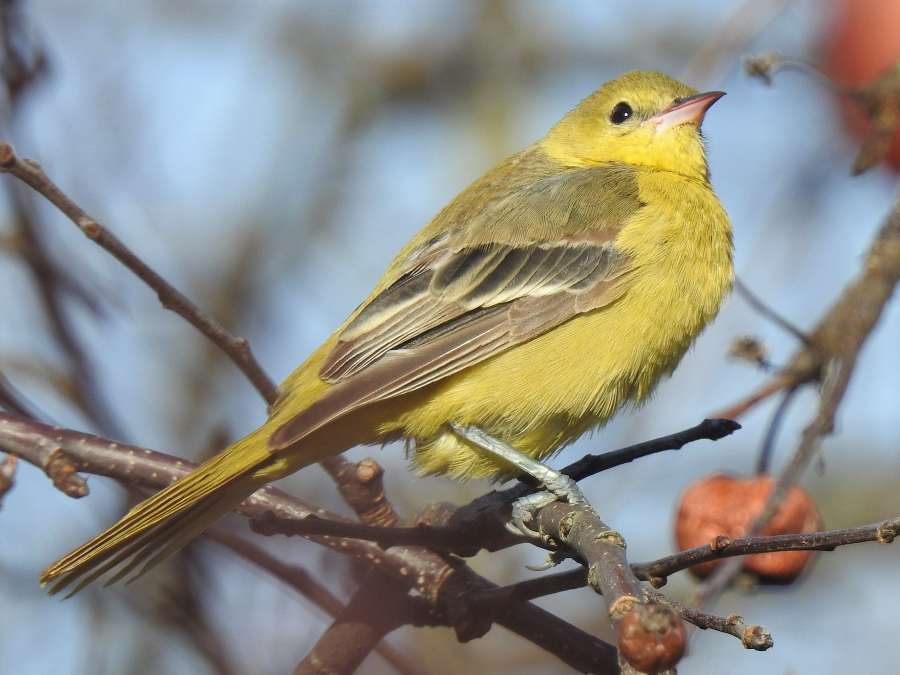
- Size: 15 – 18cm
- Weight: 16 – 28 grams
- Wingspan: 23 – 27cm
These orioles can be found in Ohio when their breeding. They will often begin breeding around late April to late May.
Orchard orioles are recognised by their orange breast and belly with their neck, head and back black in color. Females on the other hand are almost completely yellow with elements of of gray throughout their body.
As for where you can find these birds, they will often be located around semi-open habitats with deciduous trees and open space, including riverside trees, orchards, suburbs, forest edges, forest clearings and prairie groves.
These orioles like most other orioles will consume a number of unique food sources such as insects, nectar from flowers, sugar water from feeders and a number of other smaller berries and fruits.
Orchard orioles can live for around 11 years in the wild.
Amhil Khan, a dedicated nature enthusiast and the founder of BirdsOfTheWild.com, is a passionate advocate for the captivating world of avian wonders. With a deep-seated curiosity about the intricate lives of birds, Amhil’s journey began as a fascination and has evolved into a mission to inspire others to appreciate and protect these magnificent creatures.
Amhil’s love for birds led to the creation of Birds of the Wild, a platform where his expertise in ornithology, coupled with his captivating storytelling, provides readers with an immersive and educational experience. Through his lens and words, he captures the essence of birds in their natural habitats, offering a glimpse into their behaviors, migrations, and the ecosystems they inhabit.

